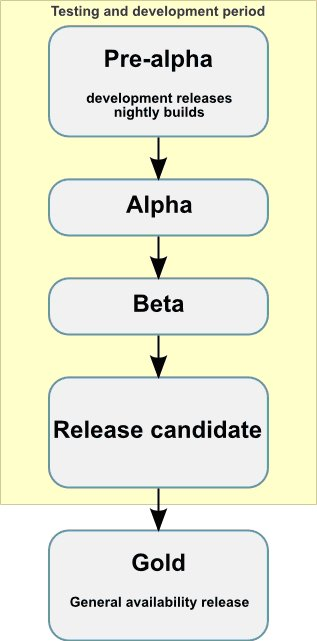Developer Documentation : Différence entre versions
(→Upgrading Thunderbird) |
(→Upgrading Thunderbird) |
||
| Ligne 191 : | Ligne 191 : | ||
| − | Extract new Thunderbird release into a directory (extracted files will be in ~/ |
+ | Extract new Thunderbird release into a directory (extracted files will be in ~/temp/comm-1.9.2): |
| − | ~$ |
+ | ~$ mkdir ~/temp |
| + | ~$ tar xvfj thunderbird-3.1.6.source.tar.bz2 -C ~/temp/ |
||
| Ligne 216 : | Ligne 216 : | ||
Update files with new versions: |
Update files with new versions: |
||
| − | ~/trustedbird/trustedbird-patch-source-3.1 (thunderbird)$ find -type f -exec cp ~/ |
+ | ~/trustedbird/trustedbird-patch-source-3.1 (thunderbird)$ find -type f -exec cp ~/temp/comm-1.9.2/{} {} \; |
Version du 9 novembre 2010 à 18:29
Sommaire
[masquer]Versioning convention
This chapter describes best practices for managing versions of universal messaging client Trustedbird and add-ons developed.
Version identifies the state of a program in its development. It is often associated with a numbering system which allows identification, and in some cases a symbolic name. The symbolic names are not used in this project.
Life cycle of a software
|
|
|
|
phase alpha:
| |
|
phase beta:
| |
|
release candidate:
| |
|
GA version (for General Availability):
|
Versioning usage
The version number will be as follows:
Note: the number associated with the revision, can be called maintenance.
Here is how to increment the values of the version number.
|
Values |
Why to increment |
When |
|
major |
|
As soon as developments start. |
|
minor |
|
As soon as developments start. |
|
revision |
|
Depends on the delivery of the final version:
|
|
build |
|
Each time the distribution is published. For the service integration, service quality or final customer. |
Git repository
Trustedbird sources are hosted on a Git repository.
- Browse Git repository
- Repository URL: http://adullact.net/anonscm/git/milimail/trustedbird.git
- Repository URL (with a project account): ssh://USERNAME@scm.adullact.net/scmrepos/git/milimail/trustedbird.git
The repository has 2 branches: "master" and "thunderbird".
- "master" branch holds Trustedbird email client patch and add-ons.
- "thunderbird" branch holds all the files from official Thunderbird sources which have been modified in "master" branch. This branch is used for upgrading Thunderbird when a new upstream release is available.
Build Documentation
Dependencies
Linux (Debian)
- build-essential
- ant
- git-core
- libgtk2.0-dev
- libglib1.2-dev
- libidl-dev
- libxt-dev
- zip
- unzip
- flex
- bison
- fakeroot
- dpkg-dev
- python-dev
- autoconf
- libtool
- a Java JDK for Ant (java-gcj-compat-dev, sun-java6-jdk, openjdk-6-jdk,...) or JRE
Windows
- For Thunderbird 2:
- Microsoft Visual C++ 6 with Service Pack 5 (not Service Pack 6 because Processor Pack needs SP5)
- Visual C++ 6.0 Processor Pack
- For Thunderbird 3.1:
- Microsoft Visual C++ 9 (Visual Studio 2008 Pro SP1 - Not the "Express" edition in order to build with jemalloc)
- Windows 7 SDK
- Latest MozillaBuild
- Git
- Java JRE (for Ant)
- Ant
See http://developer.mozilla.org/en/docs/Windows_Build_Prerequisites for more info.
- Add Ant path to the PATH variable in c:\mozilla-build\start-msvc9.bat:
SET PATH=%PATH%;%MOZ_TOOLS%\bin;C:\mozilla-build\apache-ant-1.8.1-bin\bin
- Launch build environment with c:\mozilla-build\start-msvc9.bat
Cloning the repository
Read only (with HTTP/HTTPS)
~$ git clone http://adullact.net/anonscm/git/milimail/trustedbird.git
Read-write (with SSH)
~$ git clone ssh://USERNAME@scm.adullact.net/scmrepos/git/milimail/trustedbird.git (replace USERNAME with your Adullact SSH username)
Building
~$ cd trustedbird/packager ~/trustedbird/packager$ cd trustedbird/packager
Download Thunderbird source file:
~/trustedbird/packager$ wget ftp://ftp.mozilla.org/pub/thunderbird/releases/3.1.6/source/thunderbird-3.1.6.source.tar.bz2
Build and package Trustedbird email client:
~/trustedbird/packager$ ant -Dversion=3.1 trustedbird
⇒ All packages will be available in trustedbird/packager/dist/
[optional] In order to build and package the add-ons developed for the project:
~/trustedbird/packager$ ant package-addons
Upgrading Thunderbird
When a new upstream release of Thunderbird is available, we need to merge the changes into Trustedbird.
In order to do so, a special Git branch ("thunderbird") is available. It contains all files from official Thunderbird sources which have been modified in "master" branch for Trustedbird.
Note: current branch will be printed inside parentheses in the following examples.
In order to do the merge of a new Thunderbird release, we'll need to have this "thunderbird" branch in our local Git repository.
Extract new Thunderbird release into a directory (extracted files will be in ~/temp/comm-1.9.2):
~$ mkdir ~/temp ~$ tar xvfj thunderbird-3.1.6.source.tar.bz2 -C ~/temp/
Create a "thunderbird" local branch (if it doesn't already exist) which tracks the remote branch named "thunderbird":
~$ cd trustedbird ~/trustedbird (master)$ git branch thunderbird origin/thunderbird ~/trustedbird (master)$ git branch -a * master thunderbird remotes/origin/HEAD -> origin/master remotes/origin/master remotes/origin/thunderbird ~/trustedbird (master)$
Switch to "thunderbird" branch:
~/trustedbird (master)$ git checkout thunderbird ~/trustedbird (thunderbird)$ ~/trustedbird (thunderbird)$ cd trustedbird-patch-source-3.1/ ~/trustedbird/trustedbird-patch-source-3.1 (thunderbird)$
Update files with new versions:
~/trustedbird/trustedbird-patch-source-3.1 (thunderbird)$ find -type f -exec cp ~/temp/comm-1.9.2/{} {} \;
Commit changes (if any):
~/trustedbird/trustedbird-patch-source-3.1 (thunderbird)$ git commit -va
Switch back to "master" branch:
~/trustedbird/trustedbird-patch-source-3.1 (thunderbird)$ git checkout master ~/trustedbird/trustedbird-patch-source-3.1 (master)$
Merge "thunderbird" branch into "master" branch:
~/trustedbird/trustedbird-patch-source-3.1 (master)$ git merge thunderbird
Resolve conflicts (if any) and commit:
~/trustedbird/trustedbird-patch-source-3.1 (master)$ git commit -va
How to build a localized Thunderbird 2
See Build Localized Thunderbird.
SSL certificates generation
In order to sign and encrypt messages, you'll need to have certificates.
Certificates can be generated with a Perl script CA.pl supplied with openssl.
- 1) Create a certificate hierarchy in new directory demoCA/
$ /usr/lib/ssl/misc/CA.pl -newca
(type enter when prompted to create a new certificate and fill at least "Common Name" field)
- => demoCA/cacert.pem: root certificate (CA)
- 2) Create a new certificate request for a user
$ /usr/lib/ssl/misc/CA.pl -newreq
- => newkey.pem: user's private key
- => newreq.pem: certificate request for the user
- 3) Sign the certificate request with certificate authority key
$ /usr/lib/ssl/misc/CA.pl -signreq
- => newcert.pem: user's signed certificate
- 4) Convert certificate to DER format (for LDAP)
$ openssl x509 -outform DER -in newcert.pem -out newcert.der
- => newcert.der: user's signed certificate in DER format
- 5) Create PKCS#12
$ /usr/lib/ssl/misc/CA.pl -pkcs12 "Name of the certificate"
- => newcert.p12: root certificate, user's signed certificate and user's private key
- 6) Revoke a certificate
$ openssl ca -revoke newcert.pem $ openssl ca -gencrl -out crl.pem $ openssl crl -inform PEM -outform DER -in crl.pem -out crl.der
- => crl.pem/crl.der: certificate revocation list
Import a user's certificate into Thunderbird
Import newcert.p12 in "Your certificates" tab in Thunderbird certificate manager.
In "Authorities" tab in Thunderbird certificate manager, choose to trust the CA of the certificate to identify email users.
(do again step #2 to #5 to create a new certificate for another user issued by the same authority)
Manipulate DER/ASN1
Decode Base64 -> DER-encoded:
$ openssl base64 -d -in message.b64 -out message.der
View DER-encoded in human-readable text:
$ dumpasn1 message.der OR $ openssl asn1parse -in message.der -inform DER -i -dump
Decrypt DER-encoded with private key:
$ openssl smime -decrypt -in message.der -inform DER -inkey private.key.pem -out message.clear



